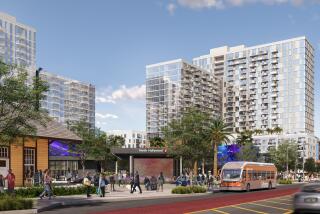San Diego loosens zoning to encourage housing construction near job sites
New mixed-use zones aim to help solve housing crisis and curb climate change
The San Diego City Council approved new zoning policies Monday allowing developers to more quickly and cheaply build large mixed-use projects featuring dense housing blended with commercial and industrial uses.
The goal is spurring more developments in suburban-style parts of the city with large surface parking lots, such as Mission Valley, Kearny Mesa, Mira Mesa and University City.
The zoning would encourage more megablock developments such as Civita in Mission Valley, which doesn’t have a traditional street grid and includes dense housing plus retail and industrial uses.
Although the changes are geared for certain areas, they would apply citywide and would allow developers to explore such projects in all San Diego neighborhoods.
City officials said the new zones would help solve the city’s housing crisis and help San Diego meet the goals of its climate action plan by encouraging more housing construction near job sites to reduce commutes.
The changes build on previous city efforts to address the housing crisis, including legislation approved last spring that wiped out parking requirements for new condominium and apartment complexes in neighborhoods near mass transit.
On Tuesday, the council is scheduled to consider a new inclusionary housing policy encouraging construction of more low-income units, and a new incentive to encourage developers to build more housing for moderate-income residents.
San Diego has long allowed mixed-use projects, but developers have had to seek special approval for the projects because they don’t adhere to the city’s existing zoning regulations.
The new policies would make mixed-use a sixth type of zone in the city, joining agriculture, open space, residential, commercial and industrial.
Property owners would need city approval to switch their zoning to mixed-use, but approvals after that would be streamlined and much more efficient than under current policies, city officials said.
And in Mission Valley and Kearny Mesa, no rezoning would be necessary because the mixed-use zones have been incorporated into new neighborhood growth blueprints — formally called community plan updates — that are nearly complete.
“This is a good idea that’s been a long time coming,” Councilman Scott Sherman said of the new mixed-use zoning policies. “This is one of those extra tools in the toolbox.”
Councilwoman Vivian Moreno said streamlining the approval process, which often takes 18 months and costs thousands of dollars, is the right move for the city. She said it’s especially appealing that the mixed-use communities will be walkable.
“It’s refreshing to see this,” Moreno said before the council’s unanimous vote Monday. The zoning policies must be approved a second time in September because they would amend the municipal code by ordinance.
The policies also encourage developers to build smaller, more affordable housing units by calculating project densities in a new way called “floor area ratio.”
Instead of allowing a certain number of units per acre, the city would allow a certain amount of square feet of housing per acre.
The policies would also loosen rules for the ground floor of mixed-use projects in response to recent trends, city officials said.
Mixed use has traditionally focused on multiple stories of housing above a ground-floor restaurant or retail shop. The ground floor often remains vacant and San Diego’s retail sector continues to shrink, primarily because of online shopping.
The new policies would broaden the types of businesses that can legally occupy the ground floor of mixed-use projects and even allow housing in some cases.
On mixed-use projects of 5 acres or more, developers would be required to provide connections to travel outside the community, such as bike lanes and walking paths, so the new development would be integrated into a neighborhood.
Developers and leaders of the life sciences industry praised the policies Monday. They said the new zoning creates opportunities for more industrial campuses that would also include housing and commercial uses.
Garrick writes for the San Diego Union-Tribune.
More to Read
Start your day right
Sign up for Essential California for news, features and recommendations from the L.A. Times and beyond in your inbox six days a week.
You may occasionally receive promotional content from the Los Angeles Times.






